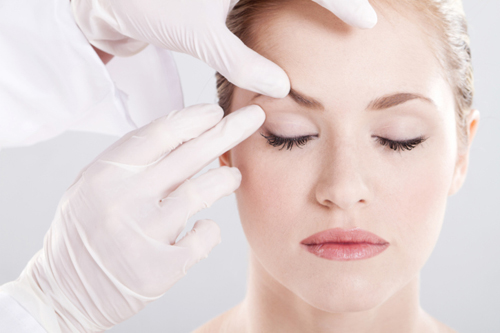It’s an all too common hurdle for patients contemplating plastic surgery – scarring. While the appeal of achieving aesthetic results through plastic surgery is tremendously enticing, the potential for post-procedure scarring is enough to make some forgo the scalpel altogether.

“Any time you cut the skin, you are going to have a resulting scar because that is the body’s healing response,” says Dr. Lawrence Shaw, founder and principal at The Shaw Center in Scottsdale. “In many cases, scars can be minimized by placement and how we treat them.”
Dr. Shaw advises patients to discuss scar-reducing methods with their plastic surgeons to make sure they have the ability and knowledge of how to reduce a scar if one were to occur. “We always do what we can intra-operatively and post-operatively to reduce scarring in the first place,” Dr. Shaw says. “If one does occur, we can institute therapy to minimize it.”
There are a bevy of options to aid in combating scar formation. Here, Dr. Shaw weighs in on the top 10 methods for reducing scarring post plastic surgery.
1. Good Surgical Technique
“Scar therapy actually starts during surgery because surgical technique is key as far as how incisions are made,” Dr. Shaw says. “Experience, meticulous tissue handling and precise approximation are all very important.”
In addition, the avoidance of using external sutures is integral in achieving the most minimal scarring, in most cases. “Most of the sutures I am using are subcuticular, or under the skin, and are absorbable, so they don’t have to be removed,” Dr. Shaw says. Avoiding external marks, also known as a railroading effect, greatly reduces the amount of scarring associated with the suture itself.
2. Genetics
When deciding on plastic surgery, Dr. Shaw advises patients to ask their plastic surgeon about their personal propensity for scarring. Points of this discussion are likely to include their probability for scarring based on their skin tone, genetics, and other scars that they might have on their body. “For example, a caesarian section scar and how it healed, when contemplating a tummy tuck procedure, would give a good indication of how you heal on that part of your body,” Dr. Shaw points out.
As a general rule, darker skin tones tend to have a greater likelihood for pigmented scars, hypertrophic (or raised) scars, and keloid scars.
3. Scar Location
“As plastic surgeons, we are trained to hide scars,” Dr. Shaw says. “There are some areas of the body that have less likelihood of scarring, even in people who are genetically predisposed to scarring.” The underarm, eyelids and facial areas tend to heal the best. While the breastbone, back, shoulders and joints are trickier places for scar healing.
4. Topical Scar Creams
Over-the-counter scar therapies can promote healing by causing a nice seal over a scar. On the horizon for topical scar therapies is a company called Novo Solutions MD, which is developing a scar cream based on the growth factors found in the serum of umbilical cords.
5. Silicon Sheeting or Tape
“Silicon sheeting is effective in treating scars by creating an atmosphere of moisture, which helps prevent the build up of bad collagen, or the collagen that causes scarring,” Dr. Shaw says. In effect, moist environments are conducive to healing and prevent the conversion of immature collagen into the type that performs scarring.
6. Kenalog (steroid) Injections
For raised scars (known as hypertrophic scars) or Keloid scars (a severe reaction where a scar is actually larger than the incision), Kenalog injections can help to reduce pain or itching and actually help to flatten the scar.
7. IPL (Intense Pulsed Light)
“All scars go through a maturation process and start by becoming pink, then red and eventually fade to white,” Dr. Shaw says. “Intense Pulsed Light (or IPL) targets red to help diminish the redness quicker and speed up healing.”
Unlike a laser, which is one wavelength, Intense Pulsed Light is a blast of light energy consisting of multiple spectrums. On average, three to five treatments of IPL may be necessary depending on a scar’s degree of redness. “Scars will improve pretty much on their own, but IPL will help the scar fade quicker,” Dr. Shaw says.
8. Microdermabrasion
Microdermabraision can be likened to a micro sandblasting of the skin using very fine crystals and can help to diminish a scar’s appearance. “It is not commonly used for scar therapy, but microdermabraision can help smooth an area and make a scar blend better,” Dr. Shaw says.
9. Surgical revision
Dr. Shaw says that sometimes re-excising a scar and instituting treatments immediately can prove successful for reducing the recurrence of a scar. “Sometimes, you can revive a scar and inject Kenalog,” Dr. Shaw says. “In severe cases, we will excise the scar and institute some radiation treatments, which has been very successful.”
10. Radiation
While radiation is typically associated with cancer therapies, radiation treatments can also work wonders for scar therapy. “To reduce scars from the start, patients go from the procedure directly to the radiation or x-ray facility and have a series of treatments done right on that scar,” Dr. Shaw says. “That has been very successful in my practice.”
To Learn More
The Shaw Center
480.767.1900
Follow Dr. Shaw on Twitter @TheShawCenter
Like Dr. Shaw on facebook
